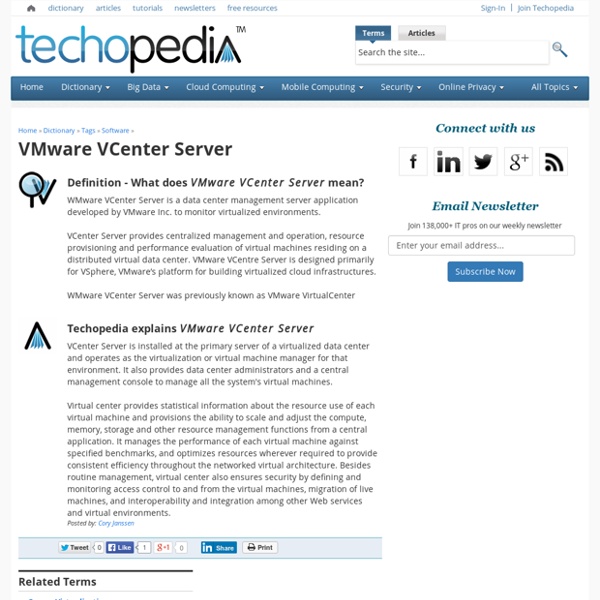



Ceilometer/blueprints/vmware-vcenter-server Although Nova provides support for VMware vCenter Server, Ceilometer does not. It does not collect metrics of virtual machines deployed on VMware virtualization platform. It will be necessary to extend this support in Ceilometer. for existing meters. create new meters in Ceilometer for which VMware vCenter Server provides data. Architectural decisions Nature of Plugin Ceilometer agents are one of the following types (refer to this for more details) Bus listener agent - the product being monitored itself generates events and posts on the Oslo notification bus from where Ceilometer will extract it. For bus listener or push agents we will require changes in VC for pushing/ publishing the performance samples, which is not possible. Executing VC APIs Pysphere, PyVmomi are currently not an option because of licensing issues. Mapping of Ceilometer Metrics and VC counters
What is VMware vCenter Server? VMware vCenter Server, formerly known as VirtualCenter, is the centralized management tool for the vSphere suite.... By submitting your email address, you agree to receive emails regarding relevant topic offers from TechTarget and its partners. You can withdraw your consent at any time. You also agree that your personal information may be transferred and processed in the United States, and that you have read and agree to the Terms of Use and the Privacy Policy. VMware vCenter Server allows for the management of multiple ESX servers and virtual machines (VMs) from different ESX servers through a single console application. All the well-known features in vSphere -- such as VMotion, Storage VMotion, Distributed Resource Scheduler, VMware High Availability and Fault Tolerance -- require vCenter Server. VMware vCenter Server comes in two versions: Standard and Foundation. vCenter Server performs the following three key functions: Figure 1 VMware vCenter Server's three main functions.
Discovery for VMware vCenter These options are available for getting VMware vCenter data: ServiceNow Discovery can run the VMWare - vCenter probe when it identifies a VMware vCenter process running on a Windows machine. ServiceNow Orchestration can run the VMWare - vCenter probe from a workflow. See VMware Component Relationships for a description of the VMware architecture and component relationships. Discovery of vCenter CIs requires at least two credentials: the Windows credential for the host on which the vCenter server runs and the VMware credential for the vCenter server. When Discovery runs, a classifier called vCenter classifies the process running on a Windows machine and launches the VMware - vCenter probe. Administrators can configure configure instances with Orchestration to run a workflow called Discover vCenter to populate the CMDB with vCenter data without having to activate the Discovery plugin. Discover vCenter Details: This related link is available to users with the vmware_operator role.
Difference between vSphere, ESXi and vCenter | MustBeGeek There is a lot of buzz of VMware virtualization solution these days. No doubt that VMware is the number one virtualization solution provider in the industry. People who are new to VMware’s virtualization platform often get confused while learning VMware vSphere and its components. So today I will be explaining all about vSphere and its components. VMware Inc. is a software company that develops many suites of software products specially for providing various virtualization solutions. vSphere is a software suite that comes under data center product. vSphere is like Microsoft Office suite which has many softwares like MS Office, MS Excel, MS Access and so on. ESXi, vSphere client and vCenter are components of vSphere. vCenter server is similar to vSphere client but it’s a server with more power. vCenter server is installed on Windows Server or Linux Server. You can install vSphere in your PC to get more knowledge of this amazing technology. The following two tabs change content below.
Review: VMware's vCenter Operations Manager lightens the load | InfoWorld One of the downsides to virtualization is the relative complexity of system monitoring. Traditional monitoring systems are well tuned for physical servers, but they can run into issues in the virtual world. When servers move freely between physical hosts, it can be a challenge to keep track of them. Also, visibility at every layer of the stack is a tough nut to crack. VMware's vCenter Operations Manager was designed to address these problems -- and it does so quite well. [ Also on InfoWorld: Take a visual tour of VMware vCenter Operations Manager. | Virtualization showdown: Microsoft Hyper-V 2012 vs. Smooth setup The framework for vCenter Operations Manager is a vApp, downloaded and deployed on a VMware vSphere cluster. The vApp is configured by default with two vCPUs on each of the two VMs, with 9GB of RAM presented to the Analytics VM and 7GB to the UI VM.